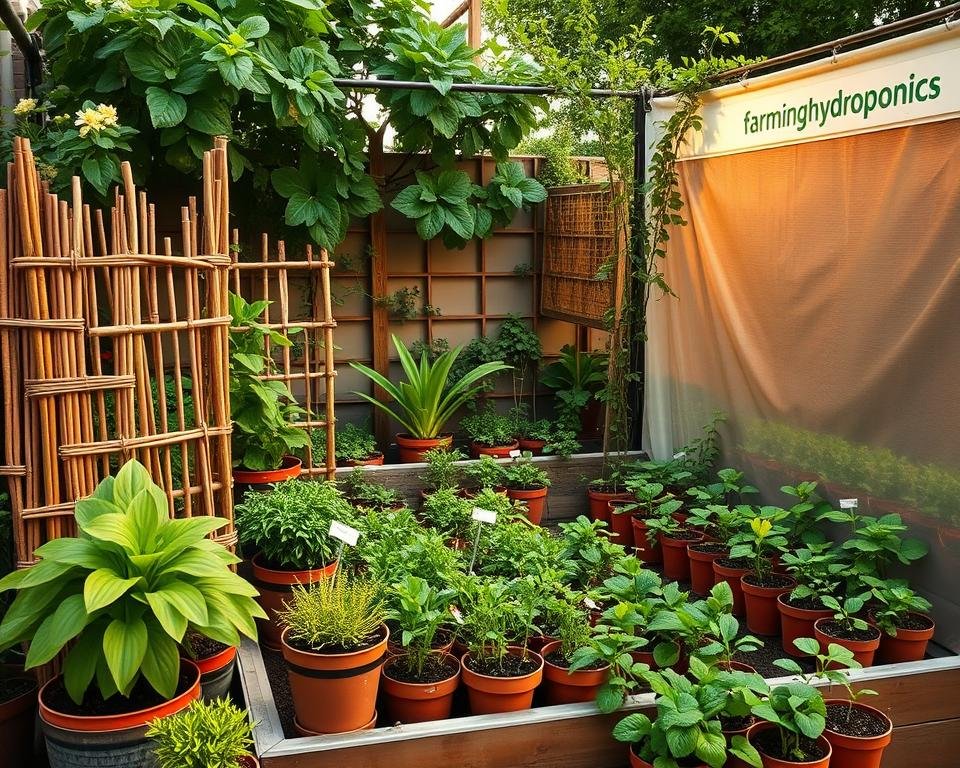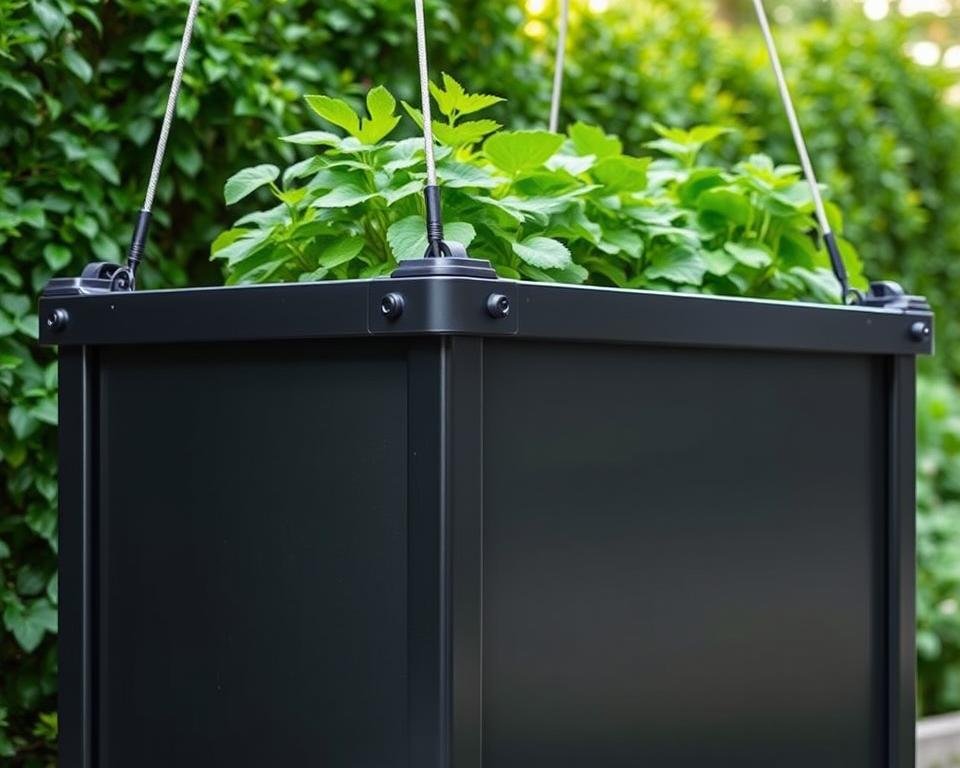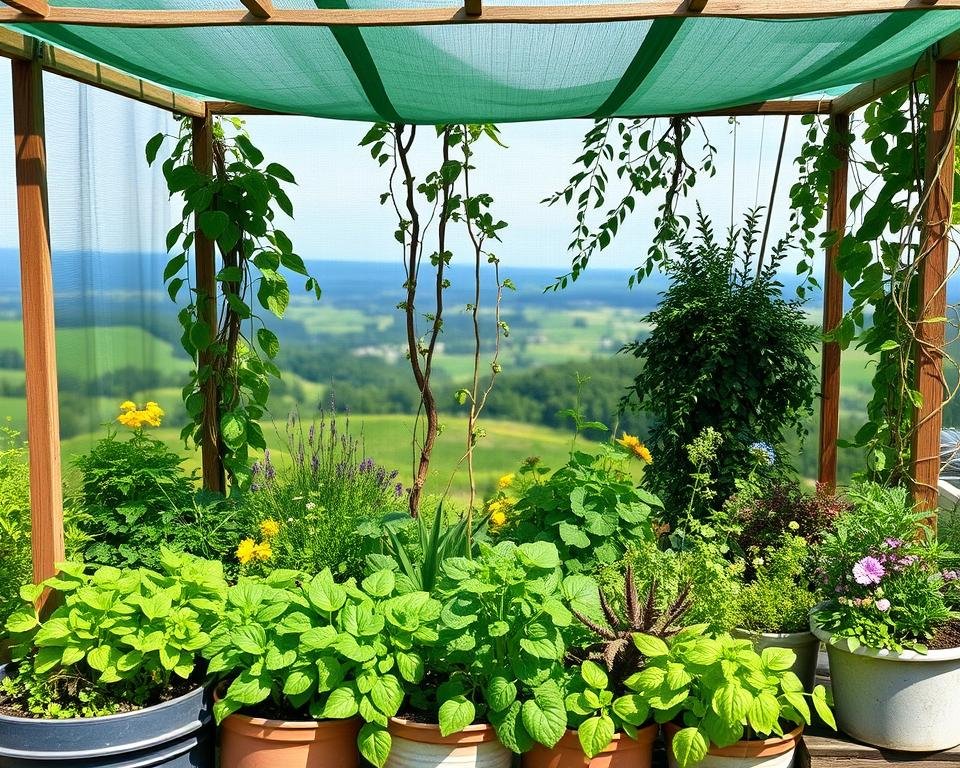Wind Protection Methods for Container Gardens
As a passionate gardener, I’ve learned the hard way that wind can be a silent destroyer of container gardens. My carefully nurtured plants have suffered brutal damage from unexpected gusts.This taught me the critical importance of using the right wind protection methods to ensure outdoor plant safety.
Wind poses a significant threat to container gardens, capable of causing devastating physical damage. Strong winds can break delicate stems, tear leaves, and compromise the structural integrity of your beloved plants. Understanding and implementing effective wind protection strategies is crucial for maintaining a thriving container-garden.
Creating a resilient garden requires strategic planning and proactive measures. By adopting smart techniques for wind protection in your container garden, you can safeguard your plants against nature’s unpredictable forces.
Key Takeaways
- Wind can cause significant physical damage to container gardens
- Strategic placement and protection are essential for plant survival
- Heavier and wider-based containers provide better wind resistance
- Clustering pots can create natural protective barriers
- Regular maintenance helps improve plant resilience
Understanding Wind’s Impact on Container Gardens
Wind can quietly destroy container gardens, causing more than just visual damage. It poses threats to your plants, making it essential to design gardens that resist wind.
Physical Damage to Plant Structures
Strong winds can harm delicate plants, leading to physical damage. This damage includes:
- Broken stems and branches
- Torn or shredded leaves
- Uprooted plants from container edges
- Bruising of soft plant tissues
Moisture Loss and Dehydration Risks
Wind speeds up water evaporation from plants and soil. Rapid moisture loss can turn a healthy garden into a stressed one. Gardeners need tips to protect their gardens from these issues.
Root System Stress Factors
Wind movement puts extra stress on roots. It can disrupt nutrient absorption and weaken plant stability. Using wind-resistant design can help reduce these risks.
Protecting your container-garden requires understanding wind’s complex interactions with plants and soil.
By understanding these wind-related challenges, you can take steps to protect your container-garden. This will help keep it healthy and thriving.
Choosing Wind-Resistant Plants for Containers

Creating a thriving container garden in windy areas needs careful plant picking. Wind protection starts with picking plants that naturally handle wind well. Some plants are naturally better at surviving strong winds.
Look for plants with traits that help them handle windy conditions. Here are some key traits:
- Slender, flexible leaves that move with wind
- Compact growth habits
- Small or narrow leaf structures
- Pliable stems that bend without breaking
Here are some top wind-resistant plants:
| Plant Type | Wind Resistance Characteristics |
|---|---|
| Ornamental Grasses | Extremely flexible, sway without damage |
| Rosemary | Compact growth, salt-tolerant |
| Lavender | Sturdy stems, drought-resistant |
| Bamboo | Dense structure, rapid growth |
When picking plants for containers, choose adaptability. Young plants grow stronger roots faster, making them more wind-resistant. Think about your garden’s environment and wind patterns to pick the best plants.
Choosing the right plants can cut down on the need for extra wind protection. By picking plants that naturally resist wind, you’ll have a stronger and more lasting outdoor space.
Wind Protection Methods
Keeping your container garden safe from wind damage needs careful planning and creative ideas. Wind barriers are key to protecting your plants from harsh winds. These winds can stress and harm your plants.

There are many ways to protect your container plants from wind. Using windbreaks and smart placement can make your garden strong. This helps your plants stay healthy and full of life.
Temporary Barriers and Screens
Temporary wind protection is great for gardeners who face changing weather. Here are some effective windshields:
- Portable fabric windbreaks that can be easily moved
- Lightweight mesh screens for partial wind reduction
- Collapsible panels that provide instant protection
Permanent Windbreaks
Long-term wind protection can change your garden’s feel. Here are some lasting solutions:
- Wooden or metal fencing with strategic spacing
- Trellises with climbing plants
- Evergreen shrubs that provide year-round wind resistance
Strategic Container Placement
Where you place your containers matters a lot. Smart placement can help:
- Positioning containers near existing structures
- Creating natural wind barriers with larger plants
- Using architectural elements like walls or hedges
Effective wind protection is about understanding and adapting to your specific garden environment.
By mixing these methods, you can build a strong defense against wind damage. This keeps your container garden healthy and lively, even in tough weather.
Container Selection and Stabilization
Protecting your container garden from wind starts with choosing the right containers. The right containers can greatly improve your garden’s wind resistance. Wind protection strategies start with knowing your containers’ key features.

Heavy materials are best for windy areas. Here are the top materials for wind resistance:
- Ceramic containers with thick walls
- Stone planters with substantial weight
- Concrete vessels with broad bases
- Metal containers with wind deflectors
Lightweight containers need extra help to stay stable. Wind deflectors help manage air flow. Use aerodynamic cladding to lessen wind pressure and safeguard roots.
| Container Type | Wind Resistance | Weight Recommendation |
|---|---|---|
| Ceramic | High | 30-50 lbs |
| Stone | Very High | 50-80 lbs |
| Concrete | Extreme | 80-120 lbs |
To boost stability, group containers and use anchoring methods. Make your garden wind-resistant by placing heavier containers as shields for delicate plants.
Essential Maintenance Practices
Keeping your container garden safe means using smart maintenance. It’s about knowing how wind affects plants and taking steps to protect them. The care you give your garden will help it stay strong against harsh weather.
Using wind fences and other protective measures can really help. Regular checks can spot damage early, so you can fix it fast. Look for signs of damage like soil compaction and root exposure after strong winds.
How you water your plants is key to their strength. Water them deeply but not too often to help roots grow strong. Use soil that holds moisture well and add organic matter to make the soil better for your plants.
Mulching is another way to protect your garden. A 2-3 inch layer of organic mulch keeps the soil moist, controls temperature, and stops soil from blowing away. Staking plants and using supports can also prevent damage from wind, keeping your garden looking great even in tough weather.







